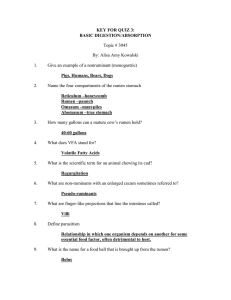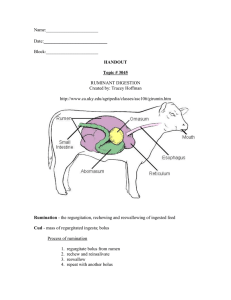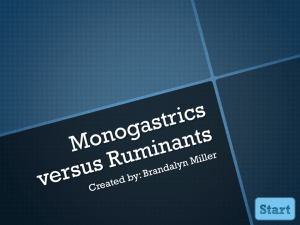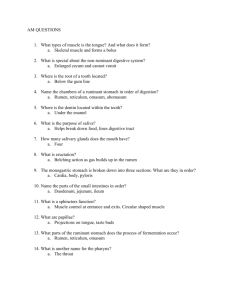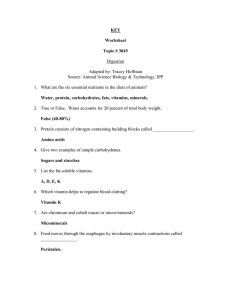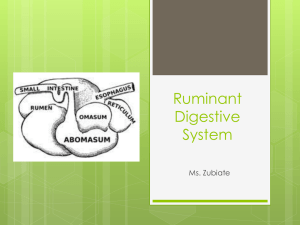Ruminant Stomach Anatomy: Rumen, Reticulum, Omasum, Abomasum
advertisement
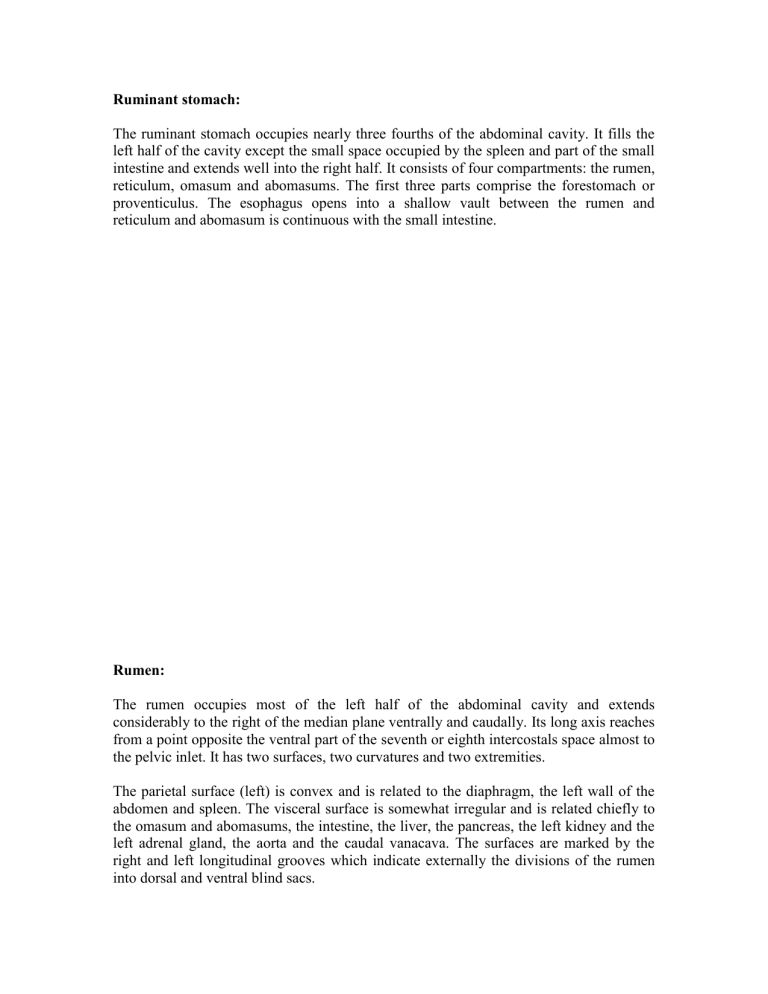
Ruminant stomach: The ruminant stomach occupies nearly three fourths of the abdominal cavity. It fills the left half of the cavity except the small space occupied by the spleen and part of the small intestine and extends well into the right half. It consists of four compartments: the rumen, reticulum, omasum and abomasums. The first three parts comprise the forestomach or proventiculus. The esophagus opens into a shallow vault between the rumen and reticulum and abomasum is continuous with the small intestine. Rumen: The rumen occupies most of the left half of the abdominal cavity and extends considerably to the right of the median plane ventrally and caudally. Its long axis reaches from a point opposite the ventral part of the seventh or eighth intercostals space almost to the pelvic inlet. It has two surfaces, two curvatures and two extremities. The parietal surface (left) is convex and is related to the diaphragm, the left wall of the abdomen and spleen. The visceral surface is somewhat irregular and is related chiefly to the omasum and abomasums, the intestine, the liver, the pancreas, the left kidney and the left adrenal gland, the aorta and the caudal vanacava. The surfaces are marked by the right and left longitudinal grooves which indicate externally the divisions of the rumen into dorsal and ventral blind sacs. The dorsal curvature is attached to the diaphragm and sublumbar muscles on the left by peritoneum and connective tissue. The ventral curvature is also convex and lies on the floor of the abdomen. The cranial extremity is divided by a transverse cranial groove into two sacs. The cranial sac is continuous caudally with the dorsal sac of rumen and cranially to the reticulum. The caudal extremity extends nearly to the pubis and is related to the intestine and bladder. It is divided into caudodorsal and caudoventral blind sacs by a deep transverse caudal groove. Reticulum: The reticulum, the most cranial and the smallest of the four compartments, located between the sixth and seventh or eighth ribs. The greater part of it lies on the left of the median plane. It is somewhat pyriform and compressed craniocaudally. The diaphragmatic surface is convex and lies against the diaphragm and the liver. The visceral surface is flattened and is related to the wall of the rumen. The lesser curvature faces to the right and dorsally and is connected with the omasum. The greater curvature faces the left and ventrally lies against the diaphragm opposite the sixth or seventh ribs. In sheep and goat the r4eticulum is relatively larger than in the ox. Omasum: The omasum is ellipsoidal in form and somewhat compressed between its parietal and visceral surfaces, long axis is nearly vertical. It lies chiefly to the right of the median plane opposite the seventh to the eleventh ribs. The parietal surface faces obliquely to the right and cranially and is related chiefly to the diaphragm and liver. The visceral surface faces in the opposite direction and is in contact with the rumen, reticulum and abomasum. It is connected in its upper part with the reticulum by a short narrow neck of the omasum. Below this it is crossed by a deep indentation. Immediately below the indentation is the extensive junction with the abomasum. Abomasum: The abomasum is an elongated sac which lies chiefly on the abdominal floor. The cranial blind end, fundus is in the xyphoid region in relation to the reticulum, cranial and ventral sac of the rumen. The body extends caudally between the ventral sac of rumen and omasum. The pyloric part turns to the right caudal to the omasum, inclines dorsally and joins the duodenum. The parietal surface is in contact with the abdominal floor while the visceral surface is related to rumen and omasum.
